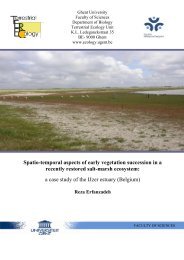PhD Arthur Decae 2010 - Ghent Ecology - Universiteit Gent
PhD Arthur Decae 2010 - Ghent Ecology - Universiteit Gent
PhD Arthur Decae 2010 - Ghent Ecology - Universiteit Gent
You also want an ePaper? Increase the reach of your titles
YUMPU automatically turns print PDFs into web optimized ePapers that Google loves.
Indian Ocean and the Strait of Gibraltar would open (probably periodically) to connect the<br />
western Mediterranean with the Atlantic again. The western Mediterranean in this period was<br />
a distinct sea from the eastern Mediterranean. Opening of the Strait of Sicily in time would<br />
renew the connection between the eastern and western parts of the Mediterranean Basin. The<br />
familiar geography of the region is now becoming visible although the major peninsulas and<br />
archipelagos as well as the connection between the Black Sea (Bosporus – Dardanelle<br />
connection) still had to develop (Fig. 4).<br />
Fig. 4 Mediterranean in the early Miocene (approx. 20myBP). The western Mediterranean is separated<br />
from the eastern Mediterranean, The Paratethyis is reduced to isolated basins and the European<br />
Continent is taking its final shape. Source: R.Blakey.ucc.nau.edu/<br />
Mediterranean Biodiversity<br />
What is the connection between the above exposé on plate tectonics and the high biodiversity<br />
in the Mediterranean The geological history sketched-out here shows that the Mediterranean<br />
was formed at the crossroads of the African, Asian and European continents (Fig. 3). So, parts<br />
of the native florae and faunae of these three continents are expected to have met and mixed<br />
within the Mediterranean leading to an increase of species richness. Moreover one of the three<br />
contributing continents, Europe, had existed as an extensive archipelago of larger and smaller<br />
islands for many millions of years. In this archipelago the evolution of island endemics must<br />
have been high and the contribution from Europe to the later Mediterranean flora and fauna<br />
must have been particularly rich. This reasoning however only relates to terrestrial<br />
biodiversity. The repeated opening and closing of seaways and the constant formation of<br />
separate aquatic basins both in the Mediterranean and the Paratethys must have had further<br />
effects of the enrichment on the marine flora and fauna of the Mediterranean. These basic<br />
conditions for the development of a particularly rich biodiversity in the Mediterranean have<br />
prevailed throughout the geological formation of the region to our present time. And there is<br />
even more than the historical high diversity of terrestrial and marine biomes in the










